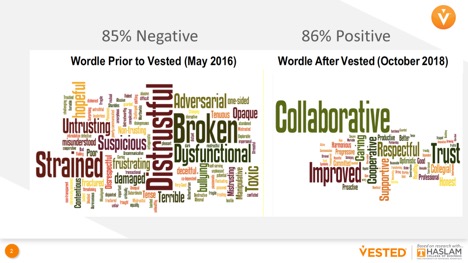Background: A publicly funded Health Authority embraced a Hospitalist service in 2000 as a quality improvement initiative. This relationship turned contentious over several contract renegotiations. With each successive contract, trust declined and the working environment became adversarial. Failed negotiations lead to a contract termination in 2015, ultimately affecting the stability of this medical service.
Purpose: The leaders wanted to rethink the traditional approach for contracting for physician services, by engaging in a new working relationship between the Health Authority and the Hospitalist group. This heralded the novel use of a formal relational contract with a medical group, with stunning results in the health of the relationship as well as real benefits to patients.
Description: Despite repeated efforts in 2015 to negotiate a contract there was a deadlock. Traditional approaches had failed, leading to a toxic and destructive working relationship. A senior executive suggested trying a newly developed methodology (Vested), which had been successfully utilised to develop formal relational contracts internationally for non-medical services. But could it be used for a physician’s services contract? With no better option we decided to give it a try.The Vested methodology uses a neutral “deal architect” who professionally facilitates a joint working team to co-create a flexible contract framework based on mutual respect, transparency and trust.In the first workshop, the parties openly discussed contract goals and concerns. Coached by a neutral facilitator, the first task was to write the preamble of the contract with a formal Shared Vision, Statement of Intent, and Guiding Principles. This catalyst reset the relationship. We committed to behaviors such as honesty, equity, autonomy, reciprocity, loyalty and integrity in any future work together, including the contracting design workshops. Each party’s legal counsel was present throughout subsequent sessions where the relationship health was central, while cooperatively designing and drafting a contractual framework and governance structure.This process included the development of four joint teams to maintain transparency and focus our contract goals and desired outcomes: Sustainability, Best Value, Excellence and Relationship. Utilizing this methodology, we were able to nurture a highly collaborative and trusting business relationship. We began to “live into” this contract, which optimized both of our needs, a full year before the final version could be completed and signed.
Conclusions: Win-win is often said, but never actualized. The Vested relational contracting process helped us stop negotiating and instead lay the foundation for a healthy relationship with the goal to optimize the unique expertise and engagement of both physicians and administrators. The new perspective got us on the same side of the table. Relationship Health (as measured by a Compatibility and Trust Assessment) helped us realize a collaborative and trusting environment in just three short years. In addition, the governance mechanisms are resulting in innovations and efficiencies never thought possible before. The sustained positive changes in the working environment have improved job satisfaction, engagement and relationships throughout the hospital, enhancing the care for the patients we serve.

